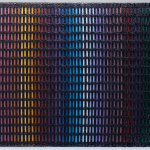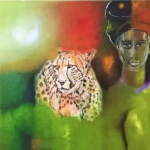
A volte il destino si delinea fin dai primi anni di vita, perché l’ambiente in cui si ha il privilegio di nascere ha il potere di aprire le porte alla creatività e alla possibilità che il sogno si trasformi in realtà; figlia d’arte, Valérie Arvalys è letteralmente cresciuta tra colori e trementina poiché sia suo nonno, pittore impressionista, sia suo padre, di stile realista, se la tenevano vicina per infonderle quell’amore per l’espressività figurativa che di fatto ha gettato le basi per tutto ciò che lei ha fatto nel corso della sua vita. La scuola di comunicazione visiva di Beaubourg a Parigi e il gruppo di pittori con cui ha partecipato a diverse esposizioni le hanno permesso di confrontarsi con stili variegati in virtù dei quali ha capito, più tardi, verso quale orientarsi in quanto più affine alla sua personalità e al suo amore per l’estetica e l’armonia delle forme. L’Art Nouveau e l’Art Deco sono le due facce della sua medaglia espressiva, il primo per la possibilità di spaziare in vari ambiti come l’architettura, la produzione artigianale di decorazioni su vetro, di gioielli, di manifesti, di ferro battuto, dando alle sue creazioni un’impronta unica e personale, il secondo per l’eleganza e il glamour che lo caratterizzano, tanto quanto per l’opulenza dei dettagli sempre in primo piano nelle opere della Arvalys. Ma il tocco che forse la caratterizza più di tutti è la poliedricità esecutiva sia dal punto di vista dei materiali con cui realizza le sue opere, come i colori acrilici, i bijoux, i sassi, fiori secchi, piume, tessuti, pelle, metallo, argilla, sia per i supporti che cambiano sulla base dell’impulso del momento dunque le sue opere possono essere su tela, su legno, su tessuto, su metallo e su vetro. E poi una personalità sperimentatrice come la sua ha bisogno di misurarsi anche con diverse tipologie di comunicazione visiva, dalla pittura alla scultura, dalla fotografia alla poesia, perché uno spirito tanto libero ed eclettico non potrebbe mai rientrare all’interno di uno schema definito e per questo limitante. Ciò che Valérie Arvalys desidera attraverso le sue opere è comunicare positività, ricordare all’osservatore che la bellezza e la fastosità, sono elementi essenziali della vita perché l’essere umano ne è da sempre attratto e perché hanno sull’interiorità un effetto rigenerante; dunque anche in questo l’artista rompe lo schema secondo il quale la superficie scintillante va in contrasto con un atteggiamento più profondo e introspettivo, al contrario per lei è proprio attraverso l’armonia estetica, la grazia e l’opulenza che l’anima può trovare sollievo e piacevolezza anche nei momenti più complessi. Impossibile infatti non lasciarsi trascinare in un’atmosfera Belle Epoque guardando le sue opere, immaginando un approccio alla vita differente, forse meno esistenzialista ma sicuramente più orientato ad approfittare di tutte le cose piacevoli che l’esistenza era in grado di offrire. Nell’opera L’envol,

la donna sembra accompagnare delicatamente il volo della rondine, lasciando che si allontani malgrado il suo affetto e la protezione che fino a quel momento le ha assicurato; non c’è senso di possesso nella figura femminile protagonista, tutt’altro, accetta amorevolmente che l’essere di cui si è presa cura intraprenda la sua strada di libertà e autonomia. Si percepisce quasi il sottile suggerimento da parte di Valérie Arvalys a non voler possedere un altro essere vivente, ciò su cui si può pensare di avere un qualche potere è solo un oggetto, qualcosa che può essere acquistato e rientrare nella propria sfera di proprietà. Nella tela L’ibis bleu

l’artista mostra tutta la sua inclinazione verso l’Art Decò, quell’opulenza di dettagli e di gamma cromatica in grado di avvolgere l’osservatore che si pone davanti all’opera rapito per l’eleganza e la raffinatezza che evoca atmosfere retrò, affascinato dal piumaggio dell’animale in perfetta armonia con il colore predominante dello sfondo e con i ricami che lo arricchiscono, come se in qualche modo la natura si trovasse a suo agio in quella signorilità che caratterizza l’ambiente raccontato dall’artista. Le figurazioni zoomorfe e floreali sono perfettamente affini alle linee guida dell’Art Nouveau che Valérie Arvalys reinterpreta con uno stile personale e assolutamente riconoscibile. Andiamo ora a scoprire di più di questa originale artista.
Valérie, ha avuto la fortuna di nascere in una famiglia di artisti, quanto può essere essenziale per un bambino avere davanti agli occhi una realtà che qualcuno crede appartenere solo al sogno? È stato vantaggioso per lei poter apprendere i segreti dell’arte prima ancora di intraprendere studi specifici? Ha ricevuto incoraggiamenti dalla sua famiglia oppure è stata messa in guardia dal perseguire una carriera complessa e spesso incerta?
È stato molto arricchente per me accarezzare con gli occhi le opere di mio nonno così colorate, così traboccanti di verità e sentire l’odore della pittura acrilica che ogni volta mi dà il desiderio irresistibile di toccarla, come un bambino che mette la mano nel barattolo di cioccolato. Per quanto riguarda mio padre con le sue opere figurative e quell’essenza di trementina mi trasportava in luoghi più antichi, ricordando Jean de la Fontaine. I loro due mondi mi hanno ispirata poeticamente. A volte con il jazz in sottofondo, a volte con la musica classica. Una sospensione nel tempo, una carezza per la mia anima. Vorrei concludere dicendo che l’arte non è un sogno. Bisogna provarla, è alla portata di tutti. Tuttavia, è essenziale lavorare ancora e ancora per trovare il proprio percorso artistico. Conoscere gli affascinanti segreti del dipingere mi ha aiutata a entrare in una scuola d’arte dove è stato notato l’amore per il colore e il saper intuitivamente come combinarlo. È stato un vero piacere completare le mie conoscenze e acquisire nuove tecniche pittoriche, dallo still life al modello dal vivo e dalla grafica al design. La mia famiglia apprezzava la mia creatività e l’armonia dei colori dei miei dipinti. Mi hanno sempre incoraggiata. Tuttavia, per diversi anni ho svolto un’altra professione in contemporanea, poiché l’arte non era sufficiente a mantenermi. Oggi mi ci dedico di più, avendo più tempo a disposizione e avendo trovato uno stile che mi somiglia, in linea con la mia personalità e i miei gusti artistici. Ora posso offrire al pubblico un viaggio più ricco e da cui può essere coinvolto ed emozionato.

Ha optato per uno stile espressivo decisamente particolare che pochi artisti contemporanei scelgono come tratto distintivo, a cosa è dovuta la sua decisione? Quanto è importante mantenere il contatto con la bellezza e con la raffinatezza nella società attuale?
Un artista deve sentirsi libero di sperimentare diverse tecniche perché la sua essenza è la creazione in sé dunque non mi interessa seguire una direzione simile a quella di altri. Noi artisti oggi siamo costantemente influenzati dal mondo che ci circonda e dalle anime dei grandi artisti, dei grandi movimenti del secolo scorso. Quindi in realtà più che scegliere uno stile, mi sono lasciata trasportare dalla mia indole, creando con un approccio molto personale, in linea con la storia dell’arte e arricchita dal mondo attuale. Ognuna delle mie realizzazioni scaturisce spontaneamente dopo aver assaporato l’universo culturale che mi piace. Ascolto semplicemente il mio cuore e ciò che amo: l’amore per la natura, l’amore per l’Art Nouveau così lussureggiante, per l’Art Déco così grafica e così inaspettata, che accarezza la mia fibra poetica e artistica. La bellezza è relativa da un continente all’altro, e la raffinatezza superficiale. Io cerco soprattutto l’armonia: quella dei colori, delle forme, delle pietre, della natura, e il modo in cui la loro singolarità si inserisce nell’insieme. Il mondo di oggi è difficile, anche se in altri tempi poteva esserlo ancora di più. Essere in grado di offrire armonia ed eleganza al nostro mondo è dare un piccolo contributo alla parte migliore di ogni persona, e a stimolare una comprensione più positiva della vita. Riuscire a trasmettere onde positive e rigeneranti, e poter usare la mia arte per far capire alle persone l’importanza di essere ciò che siamo piuttosto che diventare ciò che possediamo, è la mia missione artistica.
La sua particolarità è di aver introdotto la materia all’interno di un linguaggio stilistico originariamente legato alla tecnica pittorica più tradizionale; quanto conta per lei potersi misurare con i materiali che compongono le sue opere? Ci parla delle sue esperienze con le altre manifestazioni artistiche con cui abitualmente si misura? Come riesce a passare con tanta facilità a supporti differenti tra loro e dalla tela, come il vetro e il metallo?
Le mie creazioni sono spontanee nella linea, ma le applicazioni di vari elementi si riflettono per dare un senso, un’emozione poetica e per attrarre lo spettatore. I titoli dei miei dipinti hanno un significato. Ho anche cose da dire, da trasmettere, da far fuoriuscire. Il denominatore comune del mio percorso artistico è la grafica Vitrail. La mia arte si è evoluta con il tempo e le varie esperienze, scoprendo il mio mondo interiore, quello che volevo dire ed esprimere attraverso la grafica, i materiali e i supporti. Man mano che il percorso prosegue la mia arte si evolverà sicuramente. Mi piace aggiungere ai miei lavori tutti gli elementi che mi emozionano. L’acrilico di mio nonno; il figurativo, l’arte classica di mio padre e l’estetismo che ha saputo sviluppare in me; le pietre le cui virtù ed energie hanno un significato; l’argilla che mi piace tanto accarezzare e che è così sensuale; gli elementi di gioielleria che mi fanno pensare all’antico ferro battuto; il mosaico che mi fa viaggiare verso i paesi orientali ed evoca l’accettazione della singolarità di ognuno; gli specchi per attrarre lo spettatore; il legno, che evoca la forza della natura, che a volte scolpisco; il pizzo, che riconduce a tempi passati. Non avendo né lo spazio né il materiale per realizzare vetrate, ho assecondato questo mio desiderio cercando modi diversi per introdurlo. Ho iniziato con la grafica a pennarello, gli acrilici che circondano le forme con il nero, poi la pittura per vetri colorati ma applicata alla tela e infine quest’ultimo metodo. Si potrebbe dire che i miei dipinti sono quadri scultorei, quadri gioiello, come qualcuno li definisce. Apprezzo l’artigianato e creare questo stile è in un certo senso un omaggio agli artigiani. In merito agli altri mezzi espressivi, la poesia è entrata nella mia vita grazie a mio padre, studioso e appassionato di letteratura, storia e poesia. Jean de La Fontaine lo ha ispirato per una serie di dipinti mentre io esprimo poesia nelle mie opere come sfondo. La scrittura mi ha sempre attratta. Sono stata in grado di mettere su carta i miei sentimenti, di filosofeggiare in uno stile che è legato alla mia ispirazione del momento. La scultura invece è per me un lavoro di artigianato artistico. Ho partecipato a corsi con un maestro tedesco e ho realizzato alcune opere in argilla, da un lato modelli vivi, dall’altro personaggi molto espressivi in uno stile spontaneo. Accarezzare l’argilla mi dà una sensazione di benessere infinito; si aggiunge materia per evocare una forma, e l’opera si materializza tra le mani e davanti allo sguardo. Quando entro in contatto con il legno, inizia un altro viaggio, così come la scultura in pietra, che vorrei tanto praticare. Questi due materiali non si tradiscono e la mano che li modella non può domarli completamente. Può solo accompagnarli verso ciò che sono, ciò che dicono. Il rispetto per il materiale che viene plasmato e la sua comprensione sono per me essenziali. Oggi sono in una fase di ricerca, di uno stile che mi corrisponda di più. La fotografia mi permette di comprendere al di là dell’immagine la vita che mi circonda e con lo sguardo fissa la mia visione artistica e pittorica in un momento preciso. È il riflesso di una realtà, la nostra. Ed è questo che rende interessante la fotografia. Mi ispira anche nei miei dipinti. Osservo molto la natura, la forma dei fiori, delle piante, degli insetti, ma anche l’architettura, l’espressione dei volti e delle persone. E infine ho studiato per sette anni danza, passando dall’accademia classica al mondo del jazz moderno. Il mio desiderio, prima di tutte le pratiche artistiche che svolgo oggi, era quello di diventare una ballerina professionista, una coreografa. Questo mi avrebbe permesso di contribuire alla creazione di qualcosa di nuovo, tuttavia alcuni problemi di salute mi hanno impedito di continuare quel percorso, ma la mia personalità creativa e artistica non poteva rimanere su pensieri negativi, e la creatività mi chiamava nel profondo del mio essere. Così ho cercato di dare sfogo a questo mio lato in mille in altri modi. A mio avviso, tutte le mie espressioni artistiche compensano l’impossibilità di realizzare il mio primo sogno, quello di danzare. Posso passare da una tecnica all’altra abbastanza facilmente, perché tutto scaturisce dalla voglia di fare e di trasmettere. Sono appassionata di tutti i materiali e in particolare di quelli definiti nobili come pietra, legno, terra, ferro battuto, cuoio, seta, vetro. Oggi sono appassionata di questa tecnica, domani potrebbe essere un’altra, o una versione migliorata. Perché l’arte è viva e libera, come me.

Parlando di Art Decò non si può non pensare a Tamara de Lempicka, eppure le sue opere sembrano essere una strada nuova, un’originale mescolanza tra un Decò più Tropical che non europeo, e l’Art Nouveau di fine Ottocento. Quali sono gli artisti che l’hanno ispirata? A quali si sente più vicina dal punto di vista stilistico?
Lei cita Tamara de Lempicka, che è stata per me fonte di ispirazione durante i miei studi artistici. Apprezzo il suo lavoro per i suoi personaggi e le sue donne così femminili con forme a volte crude, a volte rotonde, ammalianti, accompagnate da colori profondi che evocano brillantemente tessuti di seta e velluto. Ma c’è anche Klimt per la sua originalità nel mescolare il figurativo classico con personaggi lasciati quasi in secondo piano a vantaggio della decorazione, di elementi decorativi floreali, tra l’altro, scintillanti di oro e di colori vividi, molto dettagliati, che ravvivano le sue opere come uno scrigno; Mucha, più in particolare nel suo periodo grafico, con le sue donne così rotondamente eleganti e poetiche, accompagnate da ornamenti vegetali tipici dell’Art Nouveau. La mia ispirazione proviene anche dai vasi e dai gioielli di Lalique, dall’arte urbana e metropolitana nonché dall’architettura di Hector Guimard e dei mobili a lui ispirati; Emile Gallé e i suoi vasi poetici. In generale, la mia ispirazione proviene da tutte le forme grafiche, siano esse architettoniche, bassorilievi, varie opere di vetro e vetrate, sculture moderne, sculture classiche o primitive; da tutte le forme artistiche: musica, natura, danza, filosofia, la storia e la poesia, il mio ambiente, ma soprattutto i sentimenti e le belle emozioni che ne derivano. I maestri a cui mi sento più vicina sono Mucha, Klimt e Guimard.

Lei partecipa attivamente a mostre collettive e alle più importanti fiere d’arte in Francia e anche all’estero: quali sono i suoi prossimi progetti?
Mi piace condividere il mio lavoro con il maggior numero di persone possibile. L’arte deve essere universale e per tutti. Da luglio ad agosto sarò in mostra personale al giardino del museo Bourdelle di Egreville dove esporrò una ventina di dipinti. A settembre, presso la galleria Thuillier al Salon de la rentrée le mie opere faranno parte di una mostra collettiva, poi a ottobre parteciperò alla Fiera internazionale d’arte contemporanea ARTSHOPPING, al Carrousel du Louvre. Da qualche mese espongo anche alla galleria Roz In Winter di Barbizon, luogo mitico della pittura pre-impressionista. Continuo a lavorare a nuovi dipinti e, parallelamente, ho in progetto di pubblicare un libro sulla mia arte. Ho anche in programma di trasformare le mie opere in vetrate, bassorilievi e sculture. La parola chiave del mio percorso artistico è condivisione. Perché l’essenza dell’arte e l’anima dell’artista non esistono se non sono condivise. L’anima di un’opera è il riflesso del suo creatore, dell’innovatore.
VALÉRIE ARVALYS-CONTATTI
Email: valerie.arvalys@gmail.com
Sito web: https://www.creations-arvalys-paris.fr/
Facebook: https://www.facebook.com/profile.php?id=100085190486986
Linkedin: https://www.linkedin.com/in/val%C3%A9rie-arvalys-aa86a9229/
Instagram: https://www.instagram.com/valeriearvalys/
Marta Lock’s interviews: Valérie Arvalys, an Art Nouveau style to recall the beauty and elegance of times gone by
Sometimes destiny is delineated from the earliest years of life, because the environment in which one is privileged to be born has the power to open the doors to creativity and the possibility of dreams becoming reality; daughter of art, Valérie Arvalys literally grew up amidst colours and turpentine as both her grandfather, an impressionist painter, and her father, a realist, kept her close to instil in her that love of figurative expressiveness that in fact laid the foundations for everything she did throughout her life. The school of visual communication at Beaubourg in Paris and the group of painters with whom she participated in various exhibitions allowed her to be confronted with a variety of styles, from which she later realised which one to turn towards as being more akin to her personality and her love for aesthetics and harmony of form. Art Nouveau and Art Deco are the two sides of her expressive coin, the former for the possibility of ranging in various spheres such as architecture, the handcrafted production of glass decorations, jewellery, posters, wrought iron, giving her creations a unique and personal imprint, the latter for the elegance and glamour that characterise it, as much as for the opulence of the details always in the foreground of Arvalys’ artworks. But the touch that perhaps characterises her most of all is her versatility of execution, both from the point of view of the materials with which she creates her works, such as acrylic colours, bijoux, stones, dried flowers, feathers, fabrics, leather, metal and clay, and the supports that change according to the impulse of the moment, so her creations can be on canvas, wood, fabric, metal and glass. And then an experimental personality like hers also needs to measure herself with different types of visual communication, from painting to sculpture, from photography to poetry, because such a free and eclectic spirit could never fit into a defined and therefore limiting scheme. What Valérie Arvalys desires through her artworks is to communicate positivity, to remind the observer that beauty and magnificence are essential elements of life because human beings have always been attracted to them and because they have a regenerating effect on our inner selves; in this, too, the artist breaks the mould according to which the glittering surface contrasts with a deeper, more introspective attitude. On the contrary, for her, it is precisely through aesthetic harmony, grace and opulence that the soul can find relief and pleasure even in the most complex moments. Indeed, it is impossible not to be drawn into a Belle Epoque atmosphere by looking at her artworks, imagining a different approach to life, perhaps less existentialist but certainly more oriented towards taking advantage of all the pleasant things existence had to offer. In the work L’envol, the woman seems to gently accompany the flight of the swallow, allowing it to drift away despite the affection and protection it has provided her up to that moment; there is no sense of possession in the female protagonist, quite the opposite, she lovingly accepts that the being she has cared for should take its path of freedom and autonomy. One can almost perceive the subtle suggestion by Valérie Arvalys not to want to possess another living being; what one can think of as having any power over is only an object, something that can be acquired and fall within one’s sphere of ownership. In the canvas L’ibis bleu, the artist shows all her inclination towards Art Deco, that opulence of detail and chromatic range capable of enveloping the observer who stands before the artwork enraptured by the elegance and refinement evoking retro atmospheres, fascinated by the plumage of the animal in perfect harmony with the predominant colour of the background and with the embroidery that enriches it, as if somehow nature were at ease in the stateliness that characterises the environment narrated by the artist. The zoomorphic and floral figurations are perfectly akin to the guidelines of Art Nouveau, which Valérie Arvalys reinterprets with a personal and utterly recognisable style. Let us now discover more about this original artist.
Valérie, you had the good fortune to be born into a family of artists, how essential can it be for a child to have before their eyes a reality that some believe belongs only to dreams? Was it advantageous for you to be able to learn the secrets of art before undertaking specific studies? Did you receive encouragement from your family or were you warned against pursuing a complex and often uncertain career?
It was very enriching for me to caress with my eyes my grandfather’s works so colourful, so brimming with truth and to smell the acrylic paint that every time gives me the irresistible desire to touch it, like a child putting his hand in the chocolate jar. As for my father with his figurative paintings and that essence of turpentine transported me to more ancient places, reminding me of Jean de la Fontaine. Their two worlds inspired me poetically. Sometimes with jazz in the background, sometimes with classical music. A suspension in time, a caress for my soul. I would like to conclude by saying that art is not a dream. You have to try it, it is within everyone’s reach. However, it is essential to work again and again to find you own artistic path. Learning the fascinating secrets of painting helped me to enter an art school where my love for colour and intuitive knowledge of how to combine it was noted. It was a real pleasure to complete my knowledge and acquire new painting techniques, from still life to live models and from graphics to design. My family appreciated my creativity and the harmony of colours in my paintings. They always encouraged me. However, for several years I did another profession at the same time, as art was not enough to support me. Today I am more dedicated to it, having more time at my disposal and having found a style that resembles me, in line with my personality and artistic tastes. Now I can offer the audience a richer journey from which they can be involved and moved.
You have opted for a very particular style of expression that few contemporary artists choose as a hallmark, what is the reason for your decision? How important is it to keep in touch with beauty and refinement in today’s society?
An artist must feel free to experiment with different techniques because his essence is creation itself so I am not interested in following a similar direction as others. We artists today are constantly influenced by the world around us and the souls of the great artists, the great movements of the last century. So actually rather than choosing a style, I let myself be carried away by my nature, creating with a very personal approach, in line with the history of art and enriched by today’s world. Each of my realisations springs spontaneously after savouring the cultural universe I like. I simply listen to my heart and what I love: the love of nature, the love of Art Nouveau so lush, Art Deco so graphic and so unexpected, which caresses my poetic and artistic fibre. Beauty is relative from one continent to another, and refinement superficial. I seek above all harmony: that of colours, shapes, stones, nature, and the way their singularity fits into the whole. Today’s world is difficult, although in other times it might have been even more so. To be able to offer harmony and elegance to our world is to make a small contribution to the better part of each person, and to stimulate a more positive understanding of life. To be able to convey positive and regenerating waves, and to be able to use my art to make people realise the importance of being what we are rather than becoming what we possess, is my artistic mission.
What is special about you is that you have introduced matter within a stylistic language originally linked to more traditional painting techniques; how important is it for you to be able to measure yourself against the materials that make up your artworks? Tell us about your experiences with the other artistic manifestations with which you usually measure yourself. How do you manage to switch so easily between different media and canvas, such as glass and metal?
My creations are spontaneous in line, but the applications of various elements are reflected to give meaning, poetic emotion and to attract the viewer. The titles of my paintings have a meaning. I also have things to say, to convey, to get across. The common denominator of my artistic journey is Vitrail graphics. My art has evolved with time and various experiences, discovering my inner world, what I wanted to say and express through graphics, materials and media. As the journey continues, my art will definitely evolve. I like to add all the elements that excite me to my work. The acrylic of my grandfather; the figurative, the classical art of my father and the aestheticism he was able to develop in me; the stones whose virtues and energies have meaning; the clay that I love to caress and that is so sensual; the elements of jewellery that make me think of antique wrought iron; the mosaic that makes me travel to oriental countries and evokes the acceptance of everyone’s singularity; mirrors to attract the viewer; wood, which evokes the power of nature, which I sometimes carve; lace, which leads back to times past. Having neither the space nor the material to make stained glass windows, I indulged this desire of mine by looking for different ways to introduce it. I started with marker graphics, acrylics surrounding the shapes with black, then stained glass paint but applied to canvas, and finally this last method. You could say that my artowrks are sculptural paintings, jewel paintings, as some call them. I appreciate craftsmanship and creating this style is in a way a homage to craftsmen. As for other means of expression, poetry came into my life thanks to my father, a scholar and lover of literature, history and poetry. Jean de La Fontaine inspired him for a series of paintings while I express poetry in my works as a background. Writing has always attracted me. I have been able to put my feelings on paper, to philosophise in a style that is linked to my inspiration of the moment. Sculpture, on the other hand, is a work of artistic craftsmanship for me. I took courses with a German master and made some artworks in clay, on the one hand living models, on the other very expressive characters in a spontaneous style. Caressing the clay gives me a feeling of infinite well-being; material is added to evoke a form, and the work materialises in my hands and before my eyes. When I come into contact with wood, another journey begins, as does stone sculpture, which I would love to practise. These two materials do not betray themselves and the hand that moulds them cannot completely tame them. It can only accompany them towards what they are, what they say. Respect for the material being moulded and understanding it are essential for me. Today I am in a phase of research, of a style that corresponds more to me. Photography allows me to understand beyond the image the life that surrounds me and with my gaze fixes my artistic and pictorial vision at a precise moment. It is a reflection of a reality, our reality. And that is what makes photography interesting. It also inspires me in my paintings. I observe nature a lot, the shape of flowers, plants, insects, but also architecture, the expression of faces and people. And finally, I studied dance for seven years, moving from the classical academy to the world of modern jazz. My wish, before all the artistic practices I do today, was to become a professional dancer, a choreographer. This would have allowed me to contribute to the creation of something new, however, some health problems prevented me from continuing on that path, but my creative and artistic personality could not remain on negative thoughts, and creativity was calling me to the depths of my being. So I tried to give vent to this side of me in a thousand other ways. In my opinion, all my artistic expressions compensate for the impossibility of realising my first dream, that of dancing. I can switch from one technique to another quite easily, because everything stems from the desire to do and to transmit. I am passionate about all materials and in particular those defined as noble such as stone, wood, earth, wrought iron, leather, silk, glass. Today I am passionate about this technique, tomorrow it could be another, or an improved version. Because art is alive and free, like me.
Talking about Art Deco, one cannot help but think of Tamara de Lempicka, yet your artworks seem to be a new direction, an original mixture of a more Tropical than European Deco, and late 19th century Art Nouveau. Which artists have inspired you? Which ones do you feel closest to stylistically?
You mention Tamara de Lempicka, who was a source of inspiration for me during my art studies. I appreciate her work for her characters and women who are so feminine with sometimes stark, sometimes round, bewitching shapes, accompanied by deep colours that brilliantly evoke silk and velvet fabrics. But there is also Klimt for his originality in mixing the classical figurative with characters left almost in the background in favour of decoration, of floral decorative elements, among other things, glittering with gold and vivid, highly detailed colours, which enliven his works like a jewel box; Mucha, more particularly in his graphic period, with his so roundly elegant and poetic women, accompanied by plant ornaments typical of Art Nouveau. My inspiration also comes from the vases and jewellery of Lalique, urban and metropolitan art as well as the architecture of Hector Guimard and the furniture inspired by him; Emile Gallé and his poetic vases. In general, my inspiration comes from all graphic forms, be it architecture, bas-reliefs, various glass and stained-glass works, modern sculptures, classical or primitive sculptures; from all art forms: music, nature, dance, philosophy, history and poetry, my environment, but above all the feelings and beautiful emotions that come from it. The masters I feel closest to are Mucha, Klimt and Guimard.
You actively participate in group exhibitions and the most important art fairs in France and also abroad: what are your next projects?
I like to share my work with as many people as possible. Art must be universal and for everyone. From July to August, I will have a solo exhibition at the garden of the Bourdelle Museum in Egreville, where I will show some 20 paintings. In September, at the Thuillier gallery at the Salon de la rentrée, my artworks will be part of a group exhibition, then in October I will participate in the ARTSHOPPING international contemporary art fair at the Carrousel du Louvre. For the past few months, I have also been exhibiting at the Roz In Winter gallery in Barbizon, a mythical place of pre-impressionist painting. I continue to work on new paintings and, in parallel, I plan to publish a book about my art. I also plan to transform my artworks into stained glass windows, bas-reliefs and sculptures. The key word in my artistic journey is sharing. Because the essence of art and the soul of the artist do not exist if they are not shared. The soul of an artwork is a reflection of its creator, the innovator.


